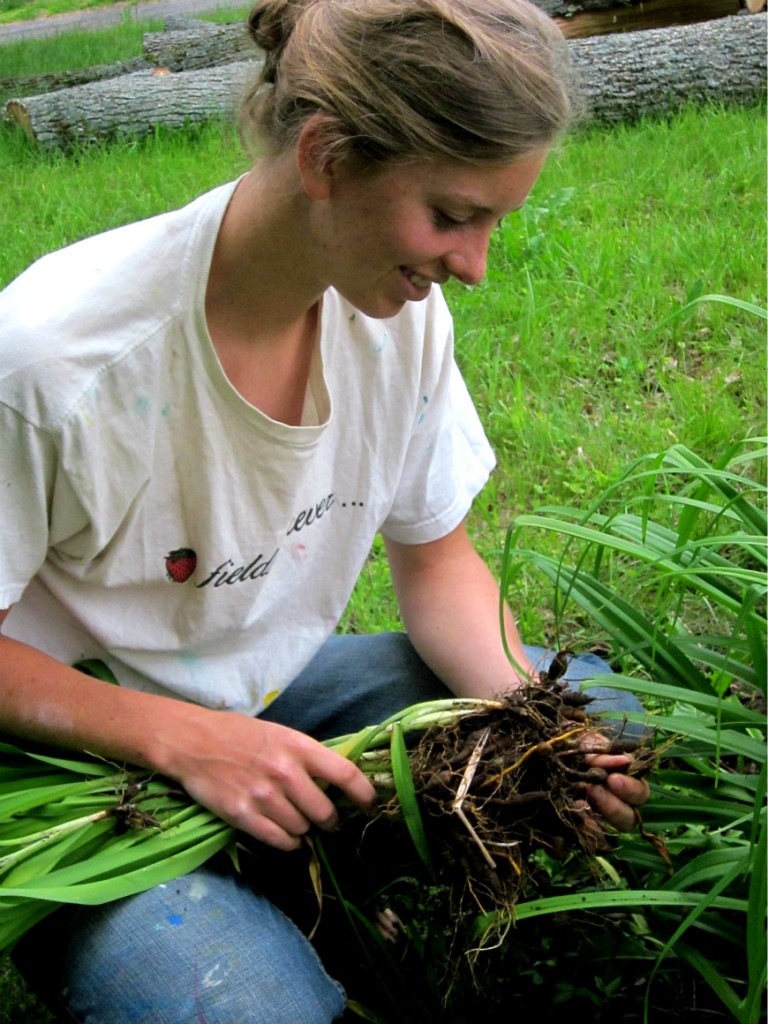Foraging food in the backyard: Daylily tubers
Growing up in Austin, Texas, was good for lots of things. Sunshine, heat, and nearly year round swimming opportunities abounded. One thing we never did, however, was attempt to eat anything that didn’t come from the grocery store. Understandably, when I arrived in upstate New York for school in 2011, my relationship with the natural world changed forever.
First, there were the obvious differences. It was impossibly green. There was water everywhere. The leaves changed color; the ground was covered in snow! Places like Canton and St. Lawrence County had long existed only in my imagination, places where wildlife sightings were a daily occurrence and I could look into the eyes of the people who had grown my food.
Then, about two years ago, I had my first taste of wild leeks. It was an absolute revelation. There were things, growing in the wild, which I could eat! Since then I’ve had the pleasure of wild leek pesto and sautés, Morrel soup, stewed dandelion greens, buttery fiddleheads, and even wild raspberries, all generally at the hands of very generous community members.
These collective experiences have seemed nothing short of exotic to me, but I know I’m only scratching the surface of wild edibles. That’s why I’ve set myself a goal for the summer – learn about, forage, and cook as many different wild edibles in the North Country as possible. There are a multitude of reasons to do so, some of the more obvious being connecting with nature, the health benefits of wild plants, and diversifying my diet.
We start with the Daylily.
Before venturing into the forest to try and discern between edible and poisonous mushrooms, I thought I’d better start with something easy to find and easy to prepare. Enter my field guide, Maggie Smith, who is working this summer as a farm intern at Little Grasse Foodworks. I heard rumors of a delicious dish she’d cooked up using the roots of the common flowering plant that can be found in fields, on the sides of roads, and in on the front lawns of most North Country homes – the Daylily.
Daylilies are incredibly prolific, so don’t fret too much about digging them up; in fact, they’re so prolific (often described as rugged, hardy, and vigorous) that thinning them out can actually be helpful for the ones you leave behind, lest they become a virtual mat that can stifle blooms. As of now the daylilies aren’t quite yet in bloom – when they do, I’m intent on sautéing some of the buds (it turns out they’re incredibly popular in Asian cooking). No, right now is a great time to cook the tuberous, bulb-y roots.
Harvesting
Maggie and I actually dug ours from a tenacious bunch on the Little Grasse Foodworks front lawn. Bring a shovel or trowel with you, dig down under the round, green, stalk, and pull the entire plant out of the ground, roots and all. What you’ll find are eight to fourteen little dirt-covered bulbs connected to each plant. These are what you want!
Cleaning
Discard the stems, and separate the bulbs (they look a lot like small fingerling potatoes) from the rest of the roots. Rinse and wash them until the dirt is gone. A sponge or brush is extremely helpful.
Cooking
The choices are endless. Daylily tubers are a lot like other tubers – think of them as a small, sweet, slightly less dense potato. Their taste is mild and pleasant. Some ways you can prepare them are:
- Boil in water for 10-15 minutes and then sauté in olive oil or butter, adding salt and pepper at the end. Or skip the sautéing and mash them into a puree.
- Bake or roast in the oven with other tubers.
- Boil whole, let cool, and then use as a stand-in carrot stick for eating with dips.
- Thinly slice and pan or stir-fry along with other vegetables.
- Throw into a soup.
I prepared mine in a faux-pho manner, inspired by the plant’s Asian roots. The basic formula for any soup is stock, plus hardy vegetables (like onions, carrots, winter squash), plus grains, plus quick-cooking vegetables. Here’s a spring chicken version that showcased the daylilies beautifully.
Spring Vegetable Soup with Day Lily Tubers
Ingredients:
- Stock (chicken, beef, vegetable, etc.)
- Onions, diced
- Daylily Tubers, washed and sliced in half
- Rice noodles
- Mushrooms, thinly sliced
- Asparagus, chopped into coins
- Fresh spring greens (spinach, chard, young kale, etc.)
- Cooked chicken or beef (optional)
Directions:
- Bring your stock to a boil in a medium to large pot.
- Add the onions and daylily tubers, allow to continue cooking at a boil for 7-10 Minutes.
- Add mushrooms and rice noodles to pot, stir to make sure the noodles don’t stick to the bottom. Allow to cook for another 7-10 minutes, until the noodles are soft.
- Add asparagus, allow to continue boiling for 2 minutes.
- Add fresh greens and pre-cooked chicken, and immediately turn off the heat. Residual heat will wilt the greens and warm the meat.
Tags: how to cook daylily tubers, how to forage daylilies, north country foraging













cool! i make daylily paper (leaves) at several different times of the year for very different sheet characteristics, and am curious to know daylily tuber as a food. i think i ate the orange flowered ones years with the amazing dr. john green cooking for a class.